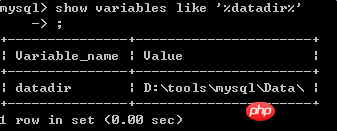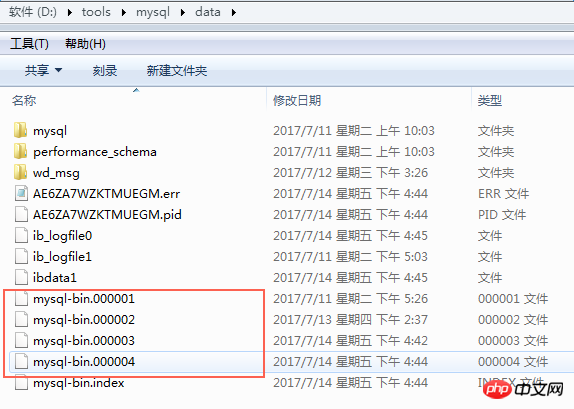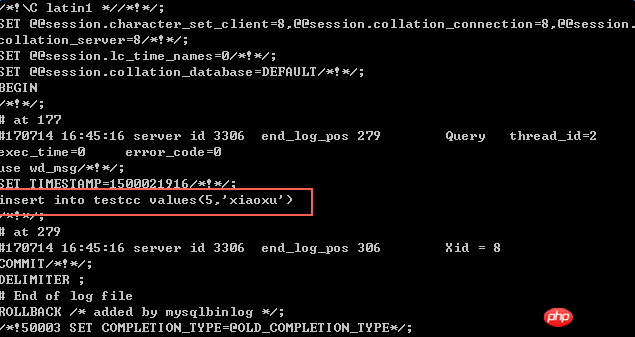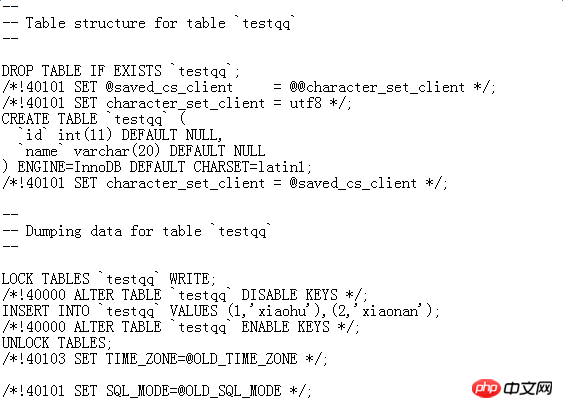Detailed explanation of MYSQL logs and backup and restore
This article mainly introduces the MYSQL log and backup and restore issues in detail. It has certain reference value. Interested friends can refer to it. I hope it can help everyone.
This article shares MYSQL logs and backups and restores for your reference. The specific content is as follows
1. Error log
When the database appears When any failure makes it unusable, check the log as soon as possible
1. Information during server startup and shutdown
2. Error information during server operation
Log storage path, you can view it through the command:

Log file naming format: host_name.err

2. Binary log
Also known as BINLOG, records all DDL statements and DML statements, excluding query statements. Not only is this log very important, but as a developer I also love this log. As can be seen from its definition, this log records all events that change the table structure and table data, so once the data is deleted accidentally or is lost due to other reasons, we can recover the data through this log. Don't you think it's cool?
Log storage path: in the same directory as the error log
Naming method: The default method is hostname-bin + number
mysql will be used every time it starts or flushes the log Generate a new binlog, with the number starting from 1 and increasing. When a single log reaches a certain size, new files are also generated.
1. Turn on the binlog recording switch
In the installation directory of myslq, there is a configuration file: my.ini

innodb_buffer_pool_size=107M # Size of each log file in a log group. You should set the combined size # of log files to about 25%-100% of your buffer pool size to avoid # unneeded buffer pool flush activity on log file overwrite. However, # note that a larger logfile size will increase the time needed for the # recovery process. innodb_log_file_size=54M # Number of threads allowed inside the InnoDB kernel. The optimal value # depends highly on the application, hardware as well as the OS # scheduler properties. A too high value may lead to thread thrashing. innodb_thread_concurrency=10 log-bin=mysql-bin
where log-bin indicates that the switch is on, and mysql-bin is the prefix of the log name.

#2. How to view BINLOG
Because it is a binary file, it cannot be viewed directly like the error log. You need to use mysql Tools provided: mysqlbinlog


3. View BINLOG
 by time
by time

One thing to note when querying by time is that start-datetime is a closed interval and stop-datetime is an open interval, so if you need to query the all-day log, you need Defined as:
--start-datetime="2017/07/12 00:00:00" --stop-datetime="2017/07/13 00:00:00": The time range of this query is 7 /12 00:00:00 - 7/12 24:59:59
3. Data backup
Data backup is actually to use the tool mysqldump provided by msyql to transfer data Back up to the specified file in the specified directory.
1. Back up the specified database or some tables in the database
mysqldump [option] db_name [table_names]
2. Back up one or more specified databases
mysqldump [option] --database db_name1 db_name2
3. Back up all databases
mysqldump [option] -all -databases
Change the port to 3306 The table structure and table data in the database wd_msg in the database instance are exported to the cd.sql file

The contents of the cd.sql file are as follows;

This file records DML statements and DDL statements, except query-related operations. During data recovery, these statements can be executed one by one to complete the data restoration.
4. Data recovery
We delete the table and re-import the data just exported:


The following scenario is to restore the wd_msg database in another mysql instance with port 3307 on the same server

The backup and restore of Mysql is for Different scenarios have different choices. Here is just one of the concepts introduced. There will be articles to introduce it in detail later.
Related recommendations:
Sample code sharing that explains the details of the MySQL log system
Introduction to mysql log recovery data method
MySQL log setting optimization
The above is the detailed content of Detailed explanation of MYSQL logs and backup and restore. For more information, please follow other related articles on the PHP Chinese website!

Hot AI Tools

Undresser.AI Undress
AI-powered app for creating realistic nude photos

AI Clothes Remover
Online AI tool for removing clothes from photos.

Undress AI Tool
Undress images for free

Clothoff.io
AI clothes remover

Video Face Swap
Swap faces in any video effortlessly with our completely free AI face swap tool!

Hot Article

Hot Tools

Notepad++7.3.1
Easy-to-use and free code editor

SublimeText3 Chinese version
Chinese version, very easy to use

Zend Studio 13.0.1
Powerful PHP integrated development environment

Dreamweaver CS6
Visual web development tools

SublimeText3 Mac version
God-level code editing software (SublimeText3)

Hot Topics
 MySQL's Role: Databases in Web Applications
Apr 17, 2025 am 12:23 AM
MySQL's Role: Databases in Web Applications
Apr 17, 2025 am 12:23 AM
The main role of MySQL in web applications is to store and manage data. 1.MySQL efficiently processes user information, product catalogs, transaction records and other data. 2. Through SQL query, developers can extract information from the database to generate dynamic content. 3.MySQL works based on the client-server model to ensure acceptable query speed.
 How to start mysql by docker
Apr 15, 2025 pm 12:09 PM
How to start mysql by docker
Apr 15, 2025 pm 12:09 PM
The process of starting MySQL in Docker consists of the following steps: Pull the MySQL image to create and start the container, set the root user password, and map the port verification connection Create the database and the user grants all permissions to the database
 Laravel Introduction Example
Apr 18, 2025 pm 12:45 PM
Laravel Introduction Example
Apr 18, 2025 pm 12:45 PM
Laravel is a PHP framework for easy building of web applications. It provides a range of powerful features including: Installation: Install the Laravel CLI globally with Composer and create applications in the project directory. Routing: Define the relationship between the URL and the handler in routes/web.php. View: Create a view in resources/views to render the application's interface. Database Integration: Provides out-of-the-box integration with databases such as MySQL and uses migration to create and modify tables. Model and Controller: The model represents the database entity and the controller processes HTTP requests.
 Solve database connection problem: a practical case of using minii/db library
Apr 18, 2025 am 07:09 AM
Solve database connection problem: a practical case of using minii/db library
Apr 18, 2025 am 07:09 AM
I encountered a tricky problem when developing a small application: the need to quickly integrate a lightweight database operation library. After trying multiple libraries, I found that they either have too much functionality or are not very compatible. Eventually, I found minii/db, a simplified version based on Yii2 that solved my problem perfectly.
 How to install mysql in centos7
Apr 14, 2025 pm 08:30 PM
How to install mysql in centos7
Apr 14, 2025 pm 08:30 PM
The key to installing MySQL elegantly is to add the official MySQL repository. The specific steps are as follows: Download the MySQL official GPG key to prevent phishing attacks. Add MySQL repository file: rpm -Uvh https://dev.mysql.com/get/mysql80-community-release-el7-3.noarch.rpm Update yum repository cache: yum update installation MySQL: yum install mysql-server startup MySQL service: systemctl start mysqld set up booting
 Centos install mysql
Apr 14, 2025 pm 08:09 PM
Centos install mysql
Apr 14, 2025 pm 08:09 PM
Installing MySQL on CentOS involves the following steps: Adding the appropriate MySQL yum source. Execute the yum install mysql-server command to install the MySQL server. Use the mysql_secure_installation command to make security settings, such as setting the root user password. Customize the MySQL configuration file as needed. Tune MySQL parameters and optimize databases for performance.
 Laravel framework installation method
Apr 18, 2025 pm 12:54 PM
Laravel framework installation method
Apr 18, 2025 pm 12:54 PM
Article summary: This article provides detailed step-by-step instructions to guide readers on how to easily install the Laravel framework. Laravel is a powerful PHP framework that speeds up the development process of web applications. This tutorial covers the installation process from system requirements to configuring databases and setting up routing. By following these steps, readers can quickly and efficiently lay a solid foundation for their Laravel project.
 MySQL vs. Other Programming Languages: A Comparison
Apr 19, 2025 am 12:22 AM
MySQL vs. Other Programming Languages: A Comparison
Apr 19, 2025 am 12:22 AM
Compared with other programming languages, MySQL is mainly used to store and manage data, while other languages such as Python, Java, and C are used for logical processing and application development. MySQL is known for its high performance, scalability and cross-platform support, suitable for data management needs, while other languages have advantages in their respective fields such as data analytics, enterprise applications, and system programming.






